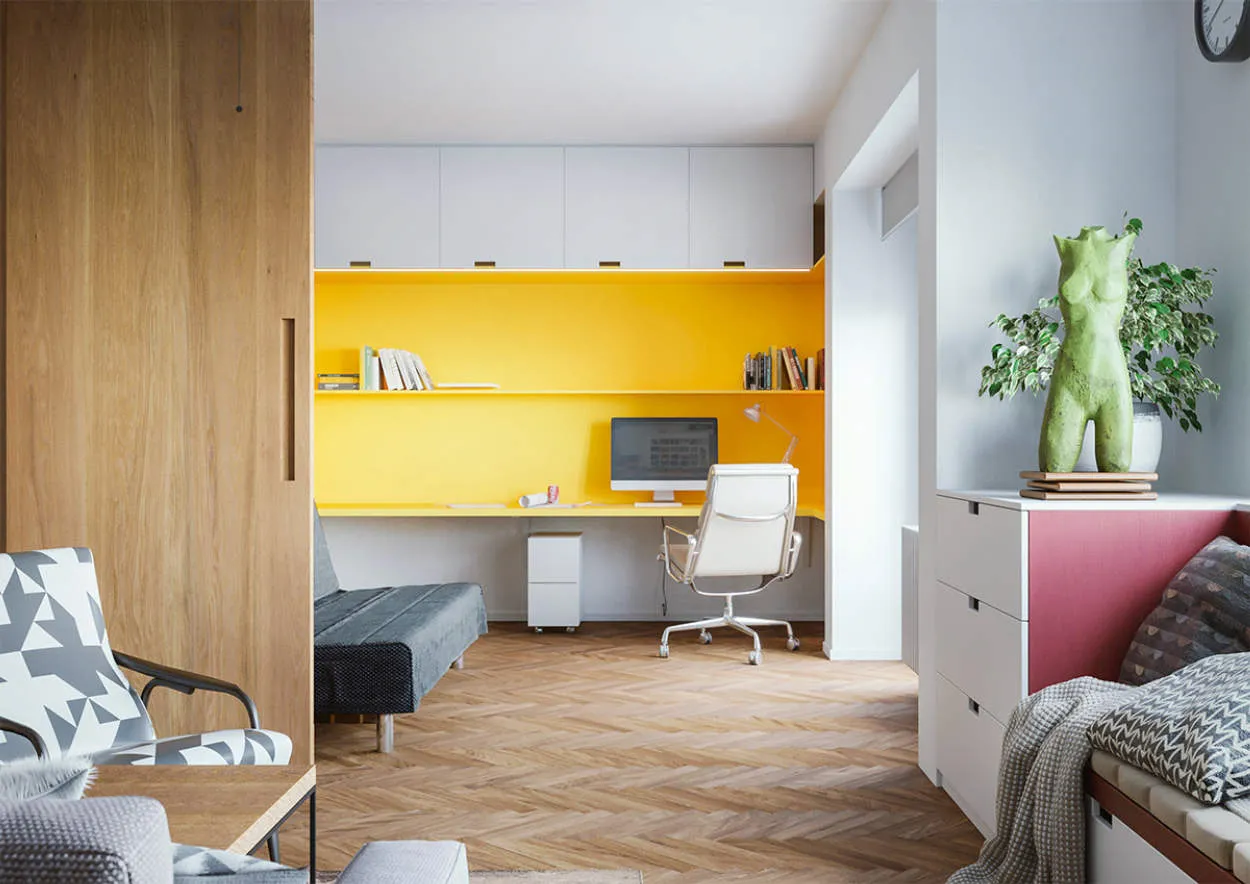Transform your living room into a creative and efficient workspace with our guide on blending comfort and productivity. Discover how to create a harmonious environment that caters to both work and relaxation, maximizing your productivity while maintaining a comfortable and inviting atmosphere.
Designing a Home Office in Your Living Room
Working from home has become increasingly common, and it’s crucial to have a dedicated workspace that promotes productivity. However, not everyone has the luxury of a separate room for a home office. If you’re looking to blend comfort and productivity, consider designing a home office in your living room.
1. Choose the Ideal Spot
Identify a quiet and well-lit corner in your living room where you can set up your workspace. Ensure that the area is away from distractions and has enough natural light to create an inviting and energizing atmosphere.
2. Define the Space
Use furniture placement to define your home office area. Positioning a desk and chair against a wall can create a clear separation between your workspace and the rest of the room. This arrangement will mentally designate the area for work and minimize distractions.
3. Invest in a Functional Desk
Select a desk that suits your needs and fits well within the available space. Consider a desk with storage options like drawers or shelves to keep your work essentials organized. A clutter-free workspace promotes focus and efficiency.
4. Ergonomic Seating
Invest in a comfortable and adjustable chair that provides proper support for your back. Sitting for extended periods without proper ergonomics can lead to discomfort and decreased productivity. Choose a chair that complements the aesthetics of your living room.
5. Adequate Lighting
Good lighting is essential for productivity and reducing eye strain. Position your desk near a window to maximize natural light. Additionally, include a task lamp on your desk for focused lighting when needed, especially during evening work sessions.
6. Maintain a Tidy Space
Keep your workspace organized and clutter-free. Invest in storage solutions such as bins or folders to keep documents and supplies neatly stored. A clean and tidy environment promotes a clear mind and allows you to focus on your tasks.
7. Personalize and Inspire
Add personal touches to make your home office feel more inviting and inspiring. Hang up artwork, display potted plants, or incorporate decorative elements that reflect your style. Creating a pleasant and comfortable environment will enhance your overall work experience.
8. Technology Setup
Ensure your home office is equipped with the necessary technology. Install a reliable internet connection and set up your computer or laptop along with any additional devices required for your work. Consider cable management solutions to keep wires organized and minimize visual clutter.
9. Maintain Work-Life Balance
As your home office is in your living room, it’s crucial to establish boundaries between work and personal life. Set designated working hours, and once your workday ends, tidy up your workspace and mentally disconnect from work to maintain a healthy work-life balance.
By implementing these tips, you can design a functional and aesthetically pleasing home office within your living room. Blend comfort and productivity to create a space that allows you to be focused, inspired, and efficient in your work.
Space-Saving Desk Solutions
When it comes to creating a workspace in your living room, finding the right balance between comfort and productivity is essential. Limited space calls for smart solutions that maximize functionality without compromising on style. Here are some space-saving desk ideas that can help you set up a productive work area in your living room:
Wall-Mounted Desks
A wall-mounted desk is a great option for small living rooms. These desks can easily be folded away when not in use, saving you precious space. They also provide a sleek and minimalist look that won’t overwhelm your living room decor.
Floating Shelves with Desk
If you have some wall space available, consider installing floating shelves with a built-in desk. This clever design allows you to make use of vertical space while providing a designated work area. You can customize the shelves to store books, documents, and other essentials.
Convertible Furniture
Investing in convertible furniture is a smart choice for small living room workspaces. Look for desks that can be easily transformed into other furniture pieces such as a dining table or a console table. This way, you can use the space for multiple purposes without sacrificing productivity.
Laptop Carts
If you prefer a flexible workspace that can be moved around, a laptop cart is an ideal option. These compact carts come with wheels for easy mobility and provide a convenient storage solution for your laptop, documents, and other work essentials.
Remember, when setting up a workspace in your living room, it’s essential to keep it organized. Utilize storage solutions like bins, baskets, and cable management systems to keep clutter at bay. With the right desk and proper organization, you can create a functional and comfortable work area that seamlessly blends into your living room.
Ergonomic Seating
Living room workspaces have become increasingly popular, especially with the rise of remote work. However, sitting for long periods of time can be detrimental to our health. This is where ergonomic seating comes into play.
Ergonomic chairs are designed to provide optimal support and comfort, reducing the risk of developing musculoskeletal disorders. They are specifically engineered to promote good posture and reduce strain on the body.
One key feature of ergonomic seating is adjustable height. This allows users to customize the chair’s height to their individual needs, ensuring that their feet are firmly planted on the ground and their knees are at a 90-degree angle.
Another important aspect is lumbar support. Ergonomic chairs often feature a curved backrest that supports the natural curve of the spine, preventing slouching and reducing back pain.
In addition, ergonomic seating prioritizes adequate cushioning. The seat should be well-padded to distribute body weight evenly and minimize pressure points.
Furthermore, armrests are considered essential in ergonomic chairs. They should be adjustable and positioned at a height that allows the arms to rest comfortably, reducing strain on the shoulders and neck.
With these ergonomic features, living room workspaces can seamlessly blend comfort and productivity. Investing in ergonomic seating can make a significant difference in our overall well-being and productivity levels.
Organizing for Efficiency
In today’s fast-paced world, finding ways to increase efficiency in our daily lives has become essential. This need for efficiency is not only limited to the workplace but also extends to our homes. In particular, our living rooms provide an excellent opportunity to create workspaces that blend comfort and productivity.
Traditionally, the living room has been associated with relaxation and leisure. However, with the increasing trend of remote work and the need to adapt to flexible schedules, incorporating a workspace within the living room can be highly beneficial.
Designating a Dedicated Space
The first step in creating an efficient living room workspace is to designate a dedicated area specifically for work-related tasks. This area should be separate from the relaxation zone to minimize distractions and ensure productivity.
Consider using a corner of the room or investing in a compact desk that fits seamlessly into the living room’s overall design. By having a designated space, you will have a better sense of focus and concentration during work hours.
Organizing and Decluttering
Efficiency thrives in an organized environment. Clutter can negatively impact productivity, so it’s important to declutter and organize your living room workspace regularly.
Invest in storage solutions such as baskets, shelves, or decorative boxes to keep your work essentials neatly organized. Utilize cable management systems to keep cords and cables out of sight, creating an uncluttered and distraction-free environment.
Comfort and Ergonomics
Working for extended periods can take a toll on your body. It’s crucial to prioritize comfort and ergonomics in your living room workspace.
Choose a comfortable chair that provides proper support for your back and invest in an adjustable desk or laptop stand to ensure an ergonomic setup. Adding cushions, footrests, and dimmable lighting can further enhance the comfort of your workspace.
Personalization and Inspiration
Adding personal touches to your living room workspace can boost motivation and creativity. Decorate the area with items that inspire you, such as motivational quotes, artwork, or plants.
Consider positioning your workspace near a window to take advantage of natural light, which not only provides a pleasant ambiance but also improves overall well-being and concentration.
Blending Work and Relaxation
While it is important to create a productive workspace, don’t neglect the room’s purpose for relaxation. Find a balance between work and leisure by incorporating elements that promote relaxation.
Add comfortable seating options, such as a cozy armchair or a soft rug where you can take breaks and unwind. Creating a designated zone for relaxation within the same room will help you maintain a healthy work-life balance.
With a well-organized and efficient living room workspace, you can seamlessly blend comfort and productivity. By implementing these strategies, you’ll be able to maximize your work output while enjoying the cozy atmosphere of your living room.
Maintaining a Work-Life Balance
When it comes to working from home, maintaining a healthy work-life balance can be a challenge. With the lines between our personal and professional lives becoming increasingly blurred, it’s important to find ways to create boundaries and prioritize self-care. This is especially true when transforming our living rooms into workspaces.
Here are a few tips to help you maintain a work-life balance while working from the comfort of your living room:
Create a dedicated workspace
Set aside a specific area in your living room that is solely dedicated to work. It could be a corner desk or a designated spot on your dining table. By separating your workspace from your relaxation space, you’ll be able to mentally switch between work mode and personal time more easily.
Establish a routine
Stick to a daily routine to create structure in your workday. Set specific hours for work and make sure to take regular breaks. This will help you stay focused during work hours and prevent burnout. Avoid the temptation to constantly check your emails outside of your designated work hours.
Set boundaries
Communicate your working hours and boundaries to your colleagues, friends, and family. Let them know when you are available and when you need uninterrupted time for work. Establishing clear boundaries will help reduce distractions and create a more efficient work environment.
Take breaks and move around
Regularly taking short breaks and moving around is crucial for your physical and mental well-being. Use your break time for stretching, taking a short walk, or doing a quick workout. These activities will help you stay energized and focused throughout the day.
Separate work and personal activities
Avoid mixing work-related tasks with personal activities during your work hours. Try not to watch TV, do household chores, or engage in other personal activities while you are supposed to be working. Dedicate your work hours solely to your job to maintain productivity and focus.
By implementing these strategies, you can create a harmonious work-life balance while working from your living room. Remember, finding the right balance is a personal journey, so feel free to adapt these tips to suit your unique circumstances.
Conclusion
Integrating workspaces into living rooms offers a harmonious blend of comfort and productivity. By creating a dedicated area within this communal space, individuals can work efficiently while enjoying the cozy ambiance of their home. Careful consideration of furniture arrangement, lighting, and storage solutions can help strike a balance between relaxation and focus. With living room workspaces, professionals can achieve a work-life balance that enhances both their personal and professional lives.




